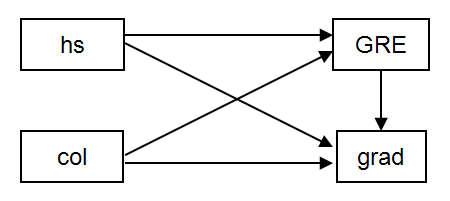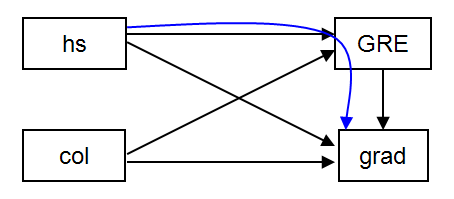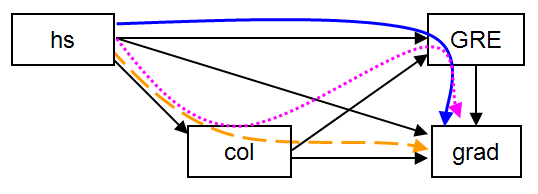Path analysis is used to estimate a system of equations in which all of the variables are observed. Unlike models that include latent variables, path models assume perfect measurement of the observed variables; only the structural relationships between the observed variables are modeled. This type of model is often used when one or more variables is thought to mediate the relationship between two others (mediation models). Similar models setups can be used to estimate models where the errors (residuals) of two otherwise unrelated dependent variables are allowed to correlated (seemingly unrelated regression), as well as models where the relationship between variables is thought to vary across groups (multiple group models).
1.0 A Just Identified Model
The examples on this page use a dataset (https://stats.idre.ucla.edu/wp-content/uploads/2016/02/path.dat) that contains four variables, the respondent’s high school gpa (hs), college gpa (col), GRE score (gre), and graduate school gpa (grad). We begin with the model illustrated below, where GRE scores are predicted using high school and college gpa (hs and col respectively); and graduate school gpa (grad) is predicted using GRE, high school gpa and college gpa. This model is just identified, meaning that it has zero degrees of freedom.
In the model: command, the keyword on is used to indicate that the model regresses gre on hs and col; and grad on hs, col, and gre. The output: command with the stdyx; option was included to obtain standardized regression coefficients and R-squared values. (The stdyx; option produces coefficients standardized on both y and x, but other types of standardization are available and can be requested using the standardized; option.)
Title: Path analysis -- just identified model
Data:
file is path.dat ;
Variable:
Names are hs gre col grad;
Model:
gre on hs col;
grad on hs col gre;
Output:
stdyx;
Here is the output from Mplus.
INPUT READING TERMINATED NORMALLY
Path analysis -- just identified model
SUMMARY OF ANALYSIS
Number of groups 1
Number of observations 200
Number of dependent variables 2
Number of independent variables 2
Number of continuous latent variables 0
Observed dependent variables
Continuous
GRE GRAD
Observed independent variables
HS COL
Estimator ML
Information matrix OBSERVED
Maximum number of iterations 1000
Convergence criterion 0.500D-04
Maximum number of steepest descent iterations 20
Input data file(s)
https://stats.idre.ucla.edu/wp-content/uploads/2016/02/path.dat
Input data format FREE
THE MODEL ESTIMATION TERMINATED NORMALLY
TESTS OF MODEL FIT
Chi-Square Test of Model Fit
Value 0.000
Degrees of Freedom 0
P-Value 0.0000
Chi-Square Test of Model Fit for the Baseline Model
Value 247.004
Degrees of Freedom 5
P-Value 0.0000
CFI/TLI
CFI 1.000
TLI 1.000
Loglikelihood
H0 Value -2789.415
H1 Value -2789.415
Information Criteria
Number of Free Parameters 9
Akaike (AIC) 5596.830
Bayesian (BIC) 5626.515
Sample-Size Adjusted BIC 5598.002
(n* = (n + 2) / 24)
RMSEA (Root Mean Square Error Of Approximation)
Estimate 0.000
90 Percent C.I. 0.000 0.000
Probability RMSEA <= .05 0.000
SRMR (Standardized Root Mean Square Residual)
Value 0.000
MODEL RESULTS
Two-Tailed
Estimate S.E. Est./S.E. P-Value
GRE ON
HS 0.309 0.065 4.756 0.000
COL 0.400 0.071 5.625 0.000
GRAD ON
HS 0.372 0.075 4.937 0.000
COL 0.123 0.084 1.465 0.143
GRE 0.369 0.078 4.754 0.000
Intercepts
GRE 15.534 2.995 5.186 0.000
GRAD 6.971 3.506 1.989 0.047
Residual Variances
GRE 49.694 4.969 10.000 0.000
GRAD 59.998 6.000 10.000 0.000
STANDARDIZED MODEL RESULTS
STDYX Standardization
Two-Tailed
Estimate S.E. Est./S.E. P-Value
GRE ON
HS 0.335 0.068 4.887 0.000
COL 0.396 0.068 5.859 0.000
GRAD ON
HS 0.356 0.070 5.073 0.000
COL 0.108 0.073 1.467 0.142
GRE 0.326 0.067 4.869 0.000
Intercepts
GRE 1.643 0.378 4.343 0.000
GRAD 0.651 0.350 1.859 0.063
Residual Variances
GRE 0.556 0.052 10.611 0.000
GRAD 0.523 0.051 10.240 0.000
R-SQUARE
Observed Two-Tailed
Variable Estimate S.E. Est./S.E. P-Value
GRE 0.444 0.052 8.477 0.000
GRAD 0.477 0.051 9.333 0.000
QUALITY OF NUMERICAL RESULTS
Condition Number for the Information Matrix 0.348E-04
(ratio of smallest to largest eigenvalue)
Under MODEL RESULTS the path coefficients (slopes) for the regression of gre on hs and col are shown, followed by those for the regression grad on hs. Along with the unstandardized coefficients (in the column labeled Estimate), the standard errors (S.E), coefficients divided by the standard errors, and a p-values are shown. From this we see that hs and col significantly predict gre, and that gre and hs (but not col) significantly predict grad. Additional parameters from the model are listed below the path coefficients. Note that the regression intercepts are listed under the heading Intercepts rather than with the path coefficients, this is different from some general purpose statistical packages where all of the coefficients (intercepts and slopes) are listed together. Because we requested standardized coefficients using the stdyx option of the output: command, the standardized results are also included in the output (after the unstandardized results). Under the heading STDYX Standardization all of the model parameters are listed, standardized so that a one unit change represents a standard deviation change in the original variable (just as in a standardized regression model). As part of the standardized output the r-squared values are presented under the heading R-SQUARE. Here the estimated r-squared value for each of the dependent variables in our model is given, along with standard errors and hypothesis tests.
1.1 Indirect and Total Effects
One of the appealing aspects of path models is the ability to assess indirect, as well as total effects (i.e. relationships among variables). Note that the total effect is the combination of the direct effect and indirect effects. In this example we will request the estimated indirect effect of hs on grad (through gre). Below is the diagram corresponding to this model with the desired indirect effect shown in blue. We can obtain the estimate of the indirect effect by adding the model indirect: command to our input file, and specifying grad ind hs;.
Here is the entire program; except for the highlighted portion of the output (and the title) this model is identical to the previous model.
Title: Path analysis -- with indirect effects.
Data:
file is path.dat ;
Variable:
Names are hs gre col grad;
Model:
gre on hs col;
grad on hs col gre;
Model indirect:
grad ind hs;
Output:
stdyx;
The output for this model is shown below, and some the output has been omitted since the output for this model is the same as the previous model except for the addition of sections showing the total, indirect and direct effects. The output is the same because we have estimated the same model; adding the indirect effects requests additional output from Mplus, but that does not change the model itself. The breakdown of the total, indirect, and direct effects appears below the MODEL RESULTS and STANDARDIZED MODEL RESULTS in a section labeled TOTAL, TOTAL INDIRECT, SPECIFIC INDIRECT, AND DIRECT EFFECTS. Because standardized coefficients were requested, the standardized total, indirect, and direct effects appear below the unstandardized effects.
MODEL RESULTS
Two-Tailed
Estimate S.E. Est./S.E. P-Value
GRE ON
HS 0.309 0.065 4.756 0.000
COL 0.400 0.071 5.625 0.000
GRAD ON
HS 0.372 0.075 4.937 0.000
COL 0.123 0.084 1.465 0.143
GRE 0.369 0.078 4.754 0.000
Intercepts
GRE 15.534 2.995 5.186 0.000
GRAD 6.971 3.506 1.989 0.047
Residual Variances
GRE 49.694 4.969 10.000 0.000
GRAD 59.998 6.000 10.000 0.000
<output omitted>
QUALITY OF NUMERICAL RESULTS
Condition Number for the Information Matrix 0.348E-04
(ratio of smallest to largest eigenvalue)
TOTAL, TOTAL INDIRECT, SPECIFIC INDIRECT, AND DIRECT EFFECTS
Two-Tailed
Estimate S.E. Est./S.E. P-Value
Effects from HS to GRAD
Total 0.487 0.075 6.453 0.000
Total indirect 0.114 0.034 3.362 0.001
Specific indirect
GRAD
GRE
HS 0.114 0.034 3.362 0.001
Direct
GRAD
HS 0.372 0.075 4.937 0.000
STANDARDIZED TOTAL, TOTAL INDIRECT, SPECIFIC INDIRECT, AND DIRECT EFFECTS
STDYX Standardization
Two-Tailed
Estimate S.E. Est./S.E. P-Value
Effects from HS to GRAD
Total 0.465 0.068 6.858 0.000
Total indirect 0.109 0.032 3.455 0.001
Specific indirect
GRAD
GRE
HS 0.109 0.032 3.455 0.001
Direct
GRAD
HS 0.356 0.070 5.073 0.000
Under Specific indirect, the effect labeled GRAD GRE HS (note each appears on its own line and the final outcome is listed first), gives the estimated coefficient for the indirect effect of hs on grad, through GRE (the blue path above). The coefficient labeled Direct is the direct effect of hs on grad. We can say that part of the total effect of hs on grad is mediated by gre scores, but the significant direct path from hs to grad suggests only partial mediation.
1.2 Specific Indirect Effects
The above example was overly simple since there was only one indirect effect. Often models will have multiple indirect effects. In this example we place a directional path (i.e. regression) from hs to col, creating a model with multiple possible indirect effects. The diagram below shows the model, with the three indirect paths we wish to examine highlighted with colored lines.
There are several ways to request calculation of indirect effects. The first, shown in the previous example (i.e. grad ind hs;) requests all indirect paths from hs to grad. We can also use ind to request a specific indirect path, for example, below we use grad ind col hs;, to specify that we want to estimate the indirect effect from hs to col to grad (i.e. the dashed orange path shown in the diagram above). Finally, we can use via to request all indirect effects that go through a third variable, for example below we use grad via gre hs; to request all indirect paths from hs to grad that involve gre, this includes hs to gre to grad (i.e. the solid blue path), and hs to col to gre to grad (i.e. the dotted pink path). The new directional path (col on hs;), as well as the specific indirect (grad ind col hs;) and via (grad via gre hs;) options of the model indirect are highlighted in the input shown below.
Title: Multiple indirect paths Data: file is path.dat ; Variable: Names are hs gre col grad; Model: gre on col hs; grad on hs col gre; col on hs; Model indirect: grad ind col hs; grad via gre hs;
The abridged output is shown below. Note that the output for this model is similar in structure to the output from earlier models, except for the addition of the section showing the indirect effects.
<output omitted>
TOTAL, TOTAL INDIRECT, SPECIFIC INDIRECT, AND DIRECT EFFECTS
Two-Tailed
Estimate S.E. Est./S.E. P-Value
Effects from HS to GRAD
Sum of indirect 0.075 0.051 1.455 0.146
Specific indirect
GRAD
COL
HS 0.075 0.051 1.455 0.146
Effects from HS to GRAD via GRE
Sum of indirect 0.204 0.047 4.333 0.000
Specific indirect
GRAD
GRE
HS 0.114 0.034 3.362 0.001
GRAD
GRE
COL
HS 0.090 0.026 3.487 0.000
In the first set of indirect effects (labeled Effects from HS to GRAD) gives the indirect effect of hs on grad through col . Although we estimated a direct effect of hs on grad in the model, this is not shown in this portion of the output (it is shown above), because we requested the specific indirect effect. The second set of indirect effects (labeled Effects from HS to GRAD via GRE) shows all possible indirect effects from hs to grad, that include GRE, in this case, there are two such effects. This portion of the output shows that hs has a significant indirect effect on grad, overall (Sum of indirect), as well as the two specific indirect effects, that is through gre, as well as through col and gre. Note that this output does not include the total effect of grad on hs, for this output we would simply specify grad ind hs; as we did in the previous model.
2.0 An Over Identified Model
This is an example of an overidentified model, that is a model with positive degrees of freedom (as opposed to the previous models which can be described as saturated or just identified). Having positive degrees of freedom allows us to examine the fit of the model using the chi-squared test of model fit, along with fit indices, for example, CFI and RMSEA. In the illustration below, paths that are included in the model are represented by solid lines; paths that could be estimated, but are not, are represented by dotted lines. Note that now hs does not have a direct effect on either grad or gre, its only influence is via col. This corresponds to the hypothesis that high school gpa is only associated with GRE scores and graduate school grades through its relationship with college gpa.
The input file for this model is shown below.
Title: Path analysis -- over identified model Data: file is path.dat ; Variable: Names are hs gre col grad; Model: col on hs; gre on col; grad on col gre; Output: stdyx;
Below is the output for this model.
INPUT READING TERMINATED NORMALLY Path analysis -- over identified model SUMMARY OF ANALYSIS Number of groups 1 Number of observations 200 Number of dependent variables 3 Number of independent variables 1 Number of continuous latent variables 0 Observed dependent variables Continuous GRE COL GRAD Observed independent variables HS Estimator ML Information matrix OBSERVED Maximum number of iterations 1000 Convergence criterion 0.500D-04
Maximum number of steepest descent iterations 20
Input data file(s)
https://stats.idre.ucla.edu/wp-content/uploads/2016/02/path.dat
Input data format FREE
THE MODEL ESTIMATION TERMINATED NORMALLY
TESTS OF MODEL FIT
Chi-Square Test of Model Fit
Value 44.429
Degrees of Freedom 2
P-Value 0.0000
Chi-Square Test of Model Fit for the Baseline Model
Value 362.474
Degrees of Freedom 6
P-Value 0.0000
CFI/TLI
CFI 0.881
TLI 0.643
Loglikelihood
H0 Value -2811.629
H1 Value -2789.415
Information Criteria
Number of Free Parameters 10
Akaike (AIC) 5643.258
Bayesian (BIC) 5676.242
Sample-Size Adjusted BIC 5644.561
(n* = (n + 2) / 24)
RMSEA (Root Mean Square Error Of Approximation)
Estimate 0.3266
90 Percent C.I. 0.247 0.412
Probability RMSEA <= .05 0.000
SRMR (Standardized Root Mean Square Residual)
Value 0.086
MODEL RESULTS
Two-Tailed
Estimate S.E. Est./S.E. P-Value
COL ON
HS 0.605 0.048 12.500 0.000
GRE ON
COL 0.625 0.056 11.101 0.000
GRAD ON
COL 0.317 0.079 4.014 0.000
GRE 0.492 0.078 6.303 0.000
Intercepts
GRE 19.887 3.009 6.609 0.000
COL 21.038 2.576 8.165 0.000
GRAD 9.779 3.664 2.669 0.008
Residual Variances
GRE 55.313 5.531 10.000 0.000
COL 49.025 4.903 10.000 0.000
GRAD 67.311 6.731 10.000 0.000
STANDARDIZED MODEL RESULTS
STDYX Standardization
Two-Tailed
Estimate S.E. Est./S.E. P-Value
COL ON
HS 0.662 0.040 16.684 0.000
GRE ON
COL 0.617 0.044 14.112 0.000
GRAD ON
COL 0.276 0.068 4.092 0.000
GRE 0.434 0.065 6.671 0.000
Intercepts
GRE 2.103 0.397 5.298 0.000
COL 2.251 0.363 6.210 0.000
GRAD 0.913 0.375 2.436 0.015
Residual Variances
GRE 0.619 0.054 11.452 0.000
COL 0.561 0.053 10.677 0.000
GRAD 0.587 0.053 11.002 0.000
R-SQUARE
Observed Two-Tailed
Variable Estimate S.E. Est./S.E. P-Value
GRE 0.381 0.054 7.056 0.000
COL 0.439 0.053 8.342 0.000
GRAD 0.413 0.053 7.743 0.000
QUALITY OF NUMERICAL RESULTS
Condition Number for the Information Matrix 0.104E-03
(ratio of smallest to largest eigenvalue)
The chi-squared value compares the current model to a saturated model. Since our model is not saturated (i.e., our model has positive degrees of freedom), the chi-squared value is no longer zero and may be used to evaluative model fit. Similarly, the CFI and TLI which were equal to one in the just identified model now take on informative values. Further down, the RMSEA and SRMR now take on informative values (in a just identified model, they are displayed as zero). Having positive degrees of freedom, and hence, informative values of the fit indices allows us to better evaluate how well our model fits the data. The specific coefficient estimates from this model are generally interpreted as they were in the just identified model.




